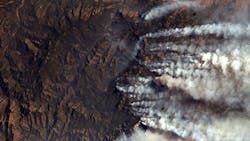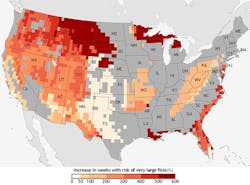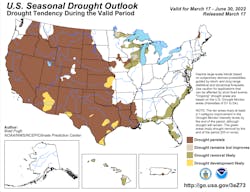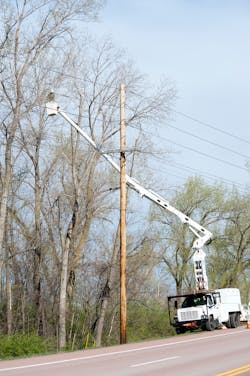Proactive Wildfire Mitigation Strategies
In 2020, nearly 18,000 structures burned as a result of wildfires. As the demand for wildfire response resources skyrockets, electric utilities face the hard question of what they’re doing to protect their networks from catastrophic fires and mass outages.
Though more wildfires occur in the eastern United States, those in the West (specifically Alaska, Arizona, California, Colorado, Hawaii, Idaho, Montana, New Mexico, Nevada, Oregon, Utah, Washington and Wyoming) burn more than 13 times the acreage. California utilities have paved the way in wildfire mitigation strategies in recent years, but expanding climate issues and rapid wildland-urban interface growth throughout the western states means that change must come quickly.
Jeff Wissing, vegetation management supervisor at Holy Cross Energy, an Overstory partner, said he has become accustomed to his utility’s five-year cycle, which has worked for a long time, but he’s seeing that this might not be the future. “We might need to reevaluate and restructure our program,” he says.
The pressure to keep pace with record-breaking heat waves, prolonged droughts and increasing tree mortality demands that utilities in those areas find better approaches to wildfire mitigation. Now, in addition to prioritizing reliability — that is, limiting the frequency and duration of disruptions to power customers — utilities must also consider resiliency — the ability to handle increasingly frequent high-impact events — more than ever before.
Investor-owned utilities and cooperatives alike can build a cost-effective wildfire mitigation plan for the future with actionable short- and long-term solutions.
Wildland-Urban Interface Expansion
Many electric utilities have seen explosive growth in total members served in recent years. The COVID pandemic in particular drove individuals to cheaper and larger housing in more rural areas, causing accelerated expansion in the wildland-urban interface (WUI).
A 2014 wildfire risk analysis of Colorado’s Front Range showed that Colorado’s WUI, combined with its distribution of public and private lands, increased the risk of fast-spreading wildfires from more remote areas to populous and vulnerable communities.
According to U.S. fire administrator, Dr. Lori Moore Merrell, climate change and increasing development in the wildland urban interface are rapidly changing the complexity and response challenges for the fire service.
“It is time for us all to recognize that wildland fire is not just a forest or rural problem any longer,” Merrell says. “Urban and suburban fire departments that had no part in wildland firefighting 30 years ago are now heavily engaged in wildland fire prevention, mitigation and response. The wildland urban interface is now the frontier for wildland fire.”
Compounding Climate Risk
Wildfire severity has compounded in recent years resulting from five key factors: rising temperatures, shorter winters, pests and disease, drought and historic fire suppression. Beyond the increased risk of ignition, diminishing vegetation health leads to increased fuel for the flames to build into megafires.
Though utilities have experienced challenging wildfire seasons in past years, what was previously only a seasonal challenge has turned into a year-round concern in high-risk areas like California and Colorado. Tree species like Douglas fir and Canyon live oak are shifting their ranges toward cooler, wetter sites. Bark beetle infestations can take an otherwise healthy-looking pine down in 30 days.
Industry experts agree that classic vegetation management strategies aren’t up to the task of facing the growing demands of the future. Rapid changes to vegetation health and climate conditions today require more frequent attention than ever before — visual inspections relying on the same predictable patterns of the past simply can’t keep up with the rate of change.
However, electric utilities can take proactive steps to build a sound wildfire mitigation strategy prioritizing both reliability and resiliency across their networks.
Principles of an Effective Wildfire Mitigation Strategy
Regulatory requirements, local conditions and available resources limit what actions utilities can take to protect their networks from catastrophic loss. While an average-sized cooperative may not be able to invest in the same cutting-edge technology solutions as a major investor-owned utility (IOU), an effective wildfire mitigation plan is within reach for both.
Vegetation management and maintaining a clear right of way (ROW) is the obvious, fastest step to stop the potential fires at their source. Many utilities revisit target areas every three to five years with cycle-based trimming plans. Unfortunately, a cycle-based plan alone does not account for cycle-busters or hazard trees that demand resources outside a traditional trimming schedule. It’s for this reason that more and more utilities are transitioning to condition-based trimming plans informed by vegetation analytics from satellite data.
Local arborists and vegetation managers often understand how different species of trees behave across a network — for example, which trees are prone to certain health issues and which trees are prone to dropping limbs. By pairing their local expertise with partners offering intelligent vegetation management plans, teams can scale their expertise faster and more reliably than they would with other methods or with more boots on the ground.
Even after a work plan has been completed, teams can use that same satellite data to confirm the quality of the work in high-risk areas during the days preceding a possible wildfire event. Spotting and understanding the conditions that precede a catastrophic wildfire requires a keen eye on factors like active fire incidents, wind, fuels, humidity and National Weather Service forecasts.
While utilities were historically limited to relying on regional weather forecasts for localized situational awareness in the past, a wide range of tools exists today to help teams anticipate hazards and high-risk weather events. Sensors on airplanes, weather balloons, utility poles, remote automated weather stations, and real-time satellite data help utilities make more informed operational decisions when dealing with windy conditions, lightning strikes and other risk situations.
Structural hardening in the form of covered conductors, wildlife exclusion devices, pole replacements and protective devices can reduce fault probability. The expected life of distribution infrastructure is about 40-50 years. Many distribution systems in the United States are approaching the 30-year mark, raising valid concerns about the rate of deterioration and probability of catastrophic faults.
A study from Electric Power Research Institute indicated that steel and fiberglass replacements for wooden poles may be effective in strengthening power line structures, though not necessarily worth their cost. Among the most successful hardening solutions are wooden poles with a higher top circumference and consecutive pole replacements of distribution lines. A tiered approach using buried distribution lines and covered conductors is also an option, though it comes at the significant cost of up to hundreds of thousands of dollars per mile of line to install, to say nothing of the increase in associated maintenance costs and response time.
Operational practices like rolling blackouts, Public Safety Power Shutoffs, may leave as many as millions of people without power for days. They’re often informed by anecdotal data from vegetation management teams that doesn’t lend itself well to such vital decision-making.
Cost-Effective Vegetation Management
Historically the costliest line item in an electric utility’s operations budget, vegetation management is also one of the most challenging tasks to consider. Because it doesn’t drive revenue, however, “successful” vegetation management strategies of the past have been effective at preventing outages but have not necessarily addressed wildfire potential. PacifiCorp proposed a more than 12% rate increase for its Oregon customers in 2023 because of “higher power costs, general inflationary pressure as well as increasing costs for wildfire planning and mitigation,” with wildfire mitigation accounting for more than 50% of that increase.
Unfortunately, as WUI and climate challenges compound, what was successful in the past has already started falling short today. Cycle busters like Colorado’s elm, ash and willow trees pose problems for utilities with limited resources to do hot-spot trimming alongside their routine cycle trimming.
Colorado’s Holy Cross Energy has faced this challenge by allocating an innovation budget for testing new methods and technologies in areas needing special attention. Satellite imagery and real-time vegetation intelligence analytics give the utility the opportunity to prioritize the most cost-effective trimming in high-impact areas rather than relying on ground reports or annual cycles alone.
While some vegetation management teams struggle with the idea of exposing themselves to analytics highlighting all of the work that needs to be done across their territories, the benefit of precise vegetation intelligence is that it helps teams prioritize exactly what work makes the highest impact with any budget.
As the financial and ecological cost of wildfires increases year after year, utilities must confront the reality of spending valuable budgets on costly fire-related insurance claims or pivot to proactive wildfire mitigation strategies that will stand up to compounding threats in the years to come.
Sticking to a Realistic Budget and Timeline
The longer electric utilities count on reactive strategies, the worse they’ll fare. As vegetation management budgets are frequently insufficient to cover the needs of an entire network, utilities must make informed, objective decisions to prioritize high-impact work.
Short-term wildfire mitigation strategies. Rather than relying solely on field intelligence from right-of-way inspectors who may need months or years to walk an entire network, utilities can use publicly available resources immediately to start making high-level decisions about impactful work across their territory.
Holy Cross Energy’s Cody O’Neil, vice president of operations, and Jeff Wissing, vegetation management supervisor, overlay a map of fire risk from the Colorado State Forest with a map of tree species in the same area. With this, they can make educated decisions on which areas are at the highest risk for wildfires without walking the entire network — and beyond that, which of those high-risk areas would suffer significant asset loss in the event of a fire.
Long-term wildfire mitigation strategies. Much of the challenge of a changing climate is that utility teams now face unprecedented and unfamiliar conditions throughout their territory. Tasked with identifying risks that haven’t occurred in their networks before, utilities must start looking outward to seek out innovative solutions used across the United States and even globally.
Kevin Dasso, former California utility executive and wildfire mitigation utility consultant, recommends exploring new technologies every three to six months and reaching out to vegetation management teams with similar challenges globally to keep up with the staggering pace of innovation.
The team at Holy Cross Energy maintains an annual innovation budget to support the increasing challenges of a wildfire-prone territory. And while measuring the effectiveness of any new solution can prove challenging, it’s a worthwhile endeavor. Effectiveness metrics are top of mind for many state regulatory bodies, including the California Public Utilities Commission (CPUC), which now requires utilities to track their mitigation efforts against distinct metrics.
Lacking real-time insight on the state of vegetation across their territories, many utilities rely on past experiences and historic data to inform their strategies, specifically with regard to fixed cycle trimming. Because of rapid population growth in WUI and changing conditions, a cycle strategy alone leaves them unable to address pressing needs without significant additional expense.
Prioritizing High-Impact Work
Electric utilities cannot optimize their wildfire mitigation strategies without timely, reliable vegetation insights across the entire service territory. However, with those insights, utilities gain the flexibility to make better decisions about when, where and how they spend their resources.
Some circuits might pose significant wildfire risk more frequently than others. Some circuits in this year’s prescribed trim cycle could wait a year or two. Better long-term decision-making depends on the ability to explore relevant vegetation insights and to use predictive modeling to prioritize effectively.
Vegetation intelligence also doesn’t necessitate costly approaches like aerial LiDAR surveys or complete databases of hundreds of thousands of individual trees. Satellite imagery supports granular and actionable insights on a much faster timeline. Utilities might consider pairing it with slower, more targeted approaches for areas of special interest or highest risk.
Implemented strategically, the solution is fast and affordable. Electric utilities can scale their own field expertise with vegetation intelligence that supports condition-based trimming in addition to their existing cycle work.
Indra den Bakker is a co-founder and CEO for Overstory, a company simplifying vegetation intelligence using machine learning and satellite imagery. Author of the Python Deep Learning Cookbook, he has a background in computational intelligence. Den Bakker’s work supports smarter decision-making about earth’s forests —
specifically around wildfire mitigation and increasingly risky climate events.
About the Author
Indra den Bakker
Indra den Bakker is a co-founder and CEO for Overstory, a company simplifying vegetation intelligence using machine learning and satellite imagery. Author of the Python Deep Learning Cookbook, he has a background in computational intelligence. Den Bakker’s work supports smarter decision-making about earth’s forests —specifically around wildfire mitigation and increasingly risky climate events.





